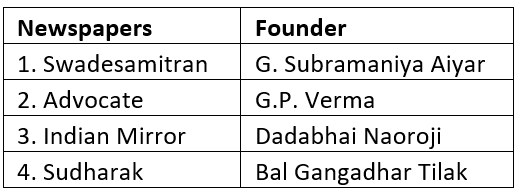JKPSC Prelims Paper 1 Mock Test - 5 - JKPSC KAS (Jammu and Kashmir) MCQ
30 Questions MCQ Test - JKPSC Prelims Paper 1 Mock Test - 5
Which of the following statements is/are correct about Shankaracharya?
1. Shankaracharya wrote the commentaries on the Upanishads and the Bhagavad Gita.
2. His philosophical views came to be known as Advaita Vedanta.
3. Shankaracharya expounded that ultimate reality is one, it being the Brahman.
Select the correct answer using the code given below:
Which joint exercise was completed by the Kharga Corps of Army and Air Force?
Which sport did India recently excel in by winning medals at the Asian Open?
What is the newly discovered marine tardigrade species called?
How many medals did India secure at the ASBC Asian U-22 and Youth Boxing Championships?
What significant historical event happened on May 9, 1788?
What is Thalassemia primarily characterized by?
Maharana Pratap is best known for which historical battle?
What did the New York Times and The Washington Post achieve in the Pulitzer Awards 2024?
Which mosquito-borne viral infection has led to alerts in Kerala?
On what date was Rabindranath Tagore's birth anniversary commemorated in 2024?
Which title did Kyren Wilson recently win in snooker?
What is the significance of the Rafah Crossing Point?
What does the idiom "When the cat goes to London, the mice dance" imply?
What is a major concern associated with Thalassemia?
What did the Indian Air Force conduct to combat a forest fire near Nainital?
Which of the following sites are identified as a Neolithic Sites?
Daojali Hading
Paiyampalli
Kurnool caves
Inamgaon
Select the correct answer using the code given below.
Which of the following sites are identified as a Neolithic Sites?
Daojali Hading
Paiyampalli
Kurnool caves
Inamgaon
Select the correct answer using the code given Below.
Consider the following statements regarding the duty of the Muqtis
1. The holders of iqta were called as Muqti.
2. The duty of the muqtis was to lead military campaigns.
3. The duty of the muqtis was to maintain law and order in their iqtas.
4. Muqtis collected the revenues of their assignments as salary.
Select the correct answer using the code given below:
Consider the following statements regarding the sculptures of medieval India:
1. One of the common features of sculptures of both Pallava and Chola dynasties was an eternal struggle between the forces of good and evil, in which the good ultimately triumphed.
2. Gajsurasamaharamurti, a Chola masterpiece shows the great goddess Durga in a fierce battle demon.
3. Pallava sculptures show females in a submissive manner with thinner features as compared to their male counterparts.
Which of the statements given above is/are correct?
With reference to Vijayanagara Empire,which one of the following is the correctchronological order of the ruling dynasties?
With reference to Medieval texts, which of the following is/are not an autobiography ?
1. Tuzuk-i-Jahangiri
2. Ain-e Akbari
3. Qanun-i-Humayuni
Select the correct answer from the codes given below :
Consider the following pairs:
1. Dadu Dayal: Madhya Pradesh
2. Ravi Das: Punjab
3. Bhagat Pipa: Bihar
Which of the pairs given above are correctly matched?
Which of the following archaeological sites belong to the Palaeolithic age?
1. Kurnool caves
2. Bhimbetka caves
3. Deojali hading
4. Chirand
5. Hunsgi
Select the correct answer using the code given Below:
Which of the following sets of pair(s) is/are correctly matched?

Select the correct answer using the code given Below:
Which of the following statements is/are correct regarding Poligars revolt?
Poligars or Palayakkars were the class of viceroys forming the second tier in the administrative system created by the Vijayanagar empire.
While the Northern Poligars fell under the kingdom of Mysore, those in southern Tamil Nadu had to deal with the revenue demands of the British east India company.
The poligars of North Arcot rose in rebellion against the company as they were deprived of their right to collect the ‘kawal’ fees.
Select the correct answer using the code given below:
Consider the following statements with respect to the Swaraj Party:
It was formed after the Gaya session of the Indian National Congress.
It was to function as a group within the Congress.
The Party won more than fifty percent of the elected seats in the Central Legislative Assembly in the 1923 elections.
Which of the statements given above are correct?
Which one of the following statements is correct with reference to the Pirpur Committee of 1938?
He laid the foundation of a new monastic order at Baranagar. He believed that the real cause of India's downfall as neglect of masses and poverty. He emphasised on two kinds of knowledge: Secular knowledge to improve their economic condition and Spiritual knowledge to infuse in them faith in themselves. Who is he?
Which of the following statements is/are correct about the Subsidiary Alliance System?
1. It was introduced by the British for the first time in India.
2. The Subsidiary Treaty Negotiation provided for non-interference by the East India Company in the internal
affairs of the Subsidiary State.
3. Europeans could be employed by a Subsidiary State only after consultation with the Company.
Select the correct answer using the code given below:














